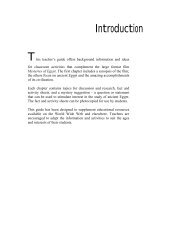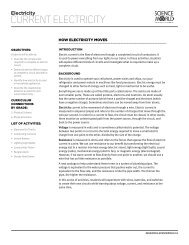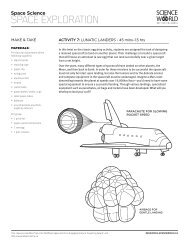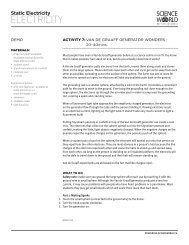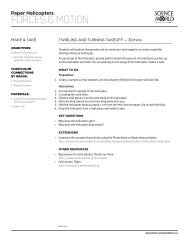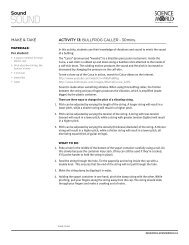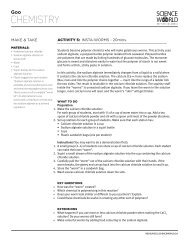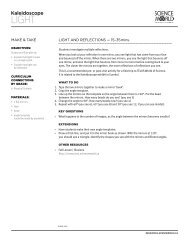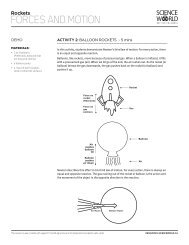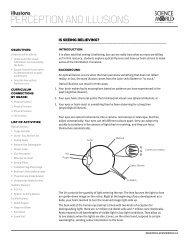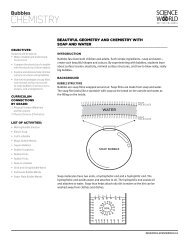Static Electricity - Science World Resources
Static Electricity - Science World Resources
Static Electricity - Science World Resources
You also want an ePaper? Increase the reach of your titles
YUMPU automatically turns print PDFs into web optimized ePapers that Google loves.
<strong>Static</strong> <strong>Electricity</strong><br />
ELECTRICITY<br />
ALL CHARGED UP<br />
OBJECTIVES:<br />
Students will be able to:<br />
• describe the movement of electrons<br />
from one material to another.<br />
• determine the resulting charge of two<br />
materials rubbing together.<br />
• explain how static charge causes<br />
materials to attract or repel each other.<br />
CURRICULUM CONNECTIONS<br />
BY GRADE:<br />
K. Physical <strong>Science</strong><br />
(properties of objects and materials)<br />
2. Physical <strong>Science</strong> (properties of matter)<br />
3. Physical <strong>Science</strong> (material and<br />
structures)<br />
5. Earth and Space <strong>Science</strong> (renewable<br />
and non-renewable resources)<br />
6. Physical <strong>Science</strong> (electricity)<br />
LIST OF ACTIVITIES:<br />
• <strong>Static</strong> <strong>Electricity</strong> Relay<br />
• Imaginary Shelf<br />
• Balloon Electroscope<br />
• Snap, Crackle, POP!<br />
• Attractive Balloons<br />
• Sticky Tape Teaser<br />
• Van de Graaff Wonders<br />
INTRODUCTION<br />
Have you ever rubbed a balloon on your head Why does rubbing a balloon on your head make<br />
your hair stand up on end<br />
When you rub the balloon, electrons move from the atoms and molecules in your hair onto<br />
the balloon. Electrons have a negative charge, so the balloon becomes negatively charged<br />
and your hair is left with a positive charge. This “separation of charge” is the reason for the<br />
collection of effects we call static electricity.<br />
Students will explore static electricity through a series of demonstrations and experiments.<br />
BACKGROUND<br />
Everything we see is made up of tiny little parts called atoms. The atoms are made of even<br />
smaller parts. These are called protons, electrons, and neutrons. An atom usually has the same<br />
number of protons and electrons. Sometimes electrons can be moved away from their atoms.<br />
If you comb your hair, electrons leave the atoms and the molecules in your hair and stay on<br />
the plastic comb. Electrons have a negative charge. The comb, covered in electrons, becomes<br />
negatively charged as well, and your hair is left with the positive charge. This “separation of<br />
charge” is the reason for the collection of effects we call static electricity.<br />
If two objects have different charges, they attract (or pull towards) each other. If two objects<br />
have the same charge, they repel (or push away) from each other. After you’ve combed your<br />
hair, each of the hairs has the same positive charge. Things with the same charge repel each<br />
other. So the hairs try to move away from each other by standing up and away from all the<br />
other hairs.<br />
If you walk across a carpet, electrons move from the rug to you. Now you have extra electrons.<br />
If you’ve got extra electrons piled on you, they will spill off when you touch an object like a<br />
doorknob, and give you a shock. Shocks come from gaining or losing electric charge in a hurry.<br />
When a charged object is brought close to a neutral material, the electrons on the neutral<br />
material will either move toward the charged object (if it has a positive charge) or away<br />
from the charged object (if it has a negative charge). In other words, the charges on the<br />
neutral object are separated by the nearby charged object. This phenomenon is called an<br />
induced charge.<br />
The result is that a normally neutral material will have a slight charge when the charged object<br />
approaches. It is enough for the two to attract.<br />
Electrostatic charges are not caused by friction, although many assume this to be the case.<br />
Background cont.<br />
RESOURCES.SCIENCEWORLD.CA
<strong>Static</strong> <strong>Electricity</strong><br />
ELECTRICITY<br />
Rubbing a balloon on your head or dragging your feet on the carpet will build up a charge,<br />
but so will ordinary walking or repeatedly touching your head with a balloon! It’s the<br />
contact between two different materials that causes charge to move from one object to<br />
another. Rubbing materials together can help move charge more quickly because more<br />
surface area is being contacted. Friction has nothing to do with the charge.<br />
An important thing to consider when doing any of these activities is the weather: humidity<br />
in the air can make it difficult to build up charges, causing experiments to behave in<br />
unexpected ways! The best “static” weather is clear, sunny, and cool.<br />
NOTES<br />
RESOURCES.SCIENCEWORLD.CA
<strong>Static</strong> <strong>Electricity</strong><br />
ELECTRICITY<br />
VOCABULARY<br />
Electron - A subatomic particle that has a negative electrical charge.<br />
Electroscope - A device that detects electrical charge.<br />
Induced charge - Separation of charges within an object caused by the proximity of a<br />
charged object.<br />
Proton - A subatomic particle that has a positive electrical charge.<br />
<strong>Static</strong> electricity - Refers to the build up of electric charges on objects. It is the charge imbalance<br />
between a negatively charged object and a positively charged object that cause the static electricity<br />
effects we see.<br />
Triboelectric series - A list that ranks various materials according to their tendency to gain or<br />
lose electrons.<br />
REFERENCES<br />
» Wikipedia | <strong>Static</strong> electricity<br />
http://en.wikipedia.org/wiki/<strong>Static</strong>_electricity<br />
» ERIC | Invitations to <strong>Science</strong> Inquiry | Imaginary shelf<br />
http://www.eric.ed.gov/PDFS/ED301471.pdf<br />
» ERIC | Invitations to <strong>Science</strong> Inquiry | Balloon electroscope<br />
http://www.eric.ed.gov/PDFS/ED301471.pdf<br />
» Wikipedia | Electroscope<br />
http://en.wikipedia.org/wiki/Electroscope<br />
» University of Virginia | Physics Education | Physical <strong>Science</strong> Activities | Balloon Electroscope<br />
http://galileo.phys.virginia.edu/Education/outreach/8thgradesol/BalloonElectroscopeFrm.htm<br />
» Discovery Education 3M Young Scientist Challenge | Balloon Electroscope<br />
http://www.youngscientistchallenge.com/checkitout/whelmers/balloon-electroscope.html<br />
» Ron Kurtus’ School for Champions | Materials that Cause <strong>Static</strong> <strong>Electricity</strong><br />
http://www.school-for-champions.com/science/static_materials.htm<br />
» Siliconfareast.com | Semiconductors | Triboelectric Series<br />
http://www.siliconfareast.com/tribo_series.htm<br />
» WonderHowTo | How to Bend Water with <strong>Static</strong> <strong>Electricity</strong><br />
http://www.wonderhowto.com/how-to-bend-water-with-static-electricity-087149/<br />
» <strong>Science</strong> Kids | Experiments | <strong>Static</strong> <strong>Electricity</strong> Experiment<br />
http://www.sciencekids.co.nz/experiments/staticelectricity.html<br />
» SchoolTube | <strong>Static</strong> Moves the Can<br />
http://www.schooltube.com/video/98e78da3e2522fcd3bf3/<strong>Static</strong>-Moves-the-Can<br />
» Digital Bits <strong>Science</strong> Lab | How to separate Salt and Pepper<br />
http://www.andybrain.com/sciencelab/2007/11/25/how-to-separate-salt-and-pepper/<br />
» SFU | <strong>Science</strong> Alive!<br />
http://www.sciencealive.ca<br />
» How Stuff Works | Van de Graaff Generators<br />
http://science.howstuffworks.com/transport/engines-equipment/vdg1.htm<br />
RESOURCES<br />
» Arbor Scientific | Van de Graaff Generator (to purchase)<br />
http://www.arborsci.com<br />
» Think Geek | Fly stick (to purchase)<br />
http://www.thinkgeek.com<br />
» Amazon | Fly stick (to purchase)<br />
http://www.amazon.ca<br />
RESOURCES.SCIENCEWORLD.CA
<strong>Static</strong> <strong>Electricity</strong><br />
ELECTRICITY<br />
DEMO ACTIVITY 1: IMAGINARY SHELF - 10mins.<br />
MATERIALS:<br />
• 10 balloons<br />
• a clean blackboard, whiteboard, or<br />
dry wall space<br />
Can you stick a balloon to the wall without glue or tape This demonstration introduces<br />
students to the concept of static electricity and explores the science behind a common<br />
party “trick”.<br />
When you rub a balloon against your sleeve, your sleeve loses some electrons. The balloon<br />
ends up with extra electrons, making it negatively charged. When the negatively charged<br />
balloon approaches a wall, the negative charges in the wall are repelled (or pushed away).<br />
This leaves a positive charge on the board at the spot where the balloon touches. It is the<br />
attraction between the positively charged area of the board and the negatively charged balloon<br />
that results in the balloon “sticking” to the board. Over time, electrons will transfer from the<br />
balloon to the board, causing the balloon to become uncharged and fall to the floor.<br />
Some materials lose electrons more easily than others. The more easily the material loses<br />
electrons, the better it will “charge up” the balloon. Wool, cotton, and hair are the most<br />
common materials to charge the balloons.<br />
WHAT TO DO<br />
1. Blow up 3 or 4 balloons. Tell students that you have constructed an invisible shelf on the<br />
blackboard.<br />
2. Rub the balloons against your sleeve or shirt as if cleaning them, then stick them to the<br />
blackboard in a horizontal row. The point is that you do not want to implicitly show them<br />
that you are actually rubbing the balloon to charge it.<br />
3. When students catch on about the rubbing of the balloons, have them try to make a second<br />
lower “shelf” with the other balloons rubbed against their hair or shirt.<br />
KEY QUESTIONS<br />
» How are the balloons sticking to the board<br />
» What did rubbing against a sleeve do to the balloon<br />
» Do the balloons stick to the wall forever Why or why not<br />
EXTENSIONS<br />
» Try rubbing a balloon against different materials such as wool, silk, cotton, plastic, hair.<br />
Do you find any difference in the static charge built up How about the length of time it sticks<br />
to the board<br />
» In teams of 6–7 students, choreograph an “electron dance”. Show the movement of electrons,<br />
the charge of the balloons and the charge of the wall.<br />
NOTES<br />
RESOURCES.SCIENCEWORLD.CA
<strong>Static</strong> <strong>Electricity</strong><br />
ELECTRICITY<br />
GAME ACTIVITY 2: STATIC ELECTRICITY RELAY - 20mins<br />
MATERIALS:<br />
• 2 balloons (plus extras in case<br />
some pop!)<br />
• a balloon pump<br />
• obstacle course supplies: hula hoops,<br />
cones, desks, chairs, etc. (enough to<br />
make two identical courses)<br />
In this activity, students use static charge to stick a balloon to themselves as they race around<br />
an obstacle course.<br />
When a balloon is rubbed against some materials, it readily captures electrons from the<br />
material. The negatively charged balloon will “stick” to a neutral object (see the explanation in<br />
“Imaginary Shelf”). Eventually, the electrons will disperse and the balloon will fall off.<br />
WHAT TO DO<br />
Set up<br />
1. Prepare two identical obstacle courses.<br />
Game<br />
1. Divide the class into 2 teams.<br />
2. The first person in each team must use static charge to stick a balloon to his or herself.<br />
3. They must then run the course with the balloon stuck to them. If the balloon falls off, they<br />
must return to the place where it fell off and re-stick it.<br />
4. Once they have completed the course, the student passes the balloon to the next team<br />
member who sticks it to herself and runs the course.<br />
5. The first team to have all their members complete the course with the balloon wins.<br />
Activity 2 cont.<br />
RESOURCES.SCIENCEWORLD.CA
<strong>Static</strong> <strong>Electricity</strong><br />
ELECTRICITY<br />
KEY QUESTIONS<br />
» Where did you stick the balloon Why<br />
» Where did the winning team stick their balloon<br />
» Why did the balloons fall off (faster or slower)<br />
EXTENSIONS<br />
» Do some kinds of clothing “stick” to balloons better than others<br />
» Do some shapes of balloons work better for this game than others<br />
NOTES<br />
RESOURCES.SCIENCEWORLD.CA
<strong>Static</strong> <strong>Electricity</strong><br />
ELECTRICITY<br />
DEMO ACTIVITY 3: BALLOON ELECTROSCOPE - 10mins.<br />
MATERIALS:<br />
• 2 identically shaped balloons<br />
• 2 lengths of thread<br />
(approx. 40 cm each)<br />
• wool cloth<br />
• a spray bottle filled with water<br />
The electroscope is an instrument used to detect electric charge. In this demonstration, a<br />
simple electroscope is made and used to visualise the effect of static charge.<br />
When you rub a balloon with a wool cloth, the balloon captures electrons from the wool,<br />
leaving the balloon with a negative charge and the wool with a positive charge. If both<br />
balloons are rubbed with wool, they will both have same charge (negative) and therefore<br />
will repel each other. When you spray water near the balloons, the water droplets carry the<br />
charges away from the balloons, leaving them uncharged. As the balloons become neutral,<br />
they will fall back together. Another way to neutralise the charges on the balloons is to touch<br />
them with a damp or moist hand.<br />
Doing static electricity experiments in damp or humid weather can sometimes have confusing<br />
or unexpected results! Moisture in the air acts just like the spray of water in this demonstration<br />
and carries charges away from objects. This makes it harder to build up charges in your<br />
experiments.<br />
WHAT TO DO<br />
1. Blow up 2 balloons to about the same size and tie a thread to each of them.<br />
2. Hold the two threads together. The balloons will hang against each other.<br />
3. Now let a student hold the threads while you rub the balloons with the wool cloth.<br />
4. Let the balloons hang back again. The balloons will not touch.<br />
5. Spray a mist of water at the balloons (they will fall back against each other).<br />
KEY QUESTIONS<br />
» Why do the balloons repel each other after rubbing<br />
» Why do the balloons fall back against each other after spraying<br />
» How else could we get the balloons to fall back against each other<br />
» During what type of weather would it be best to do experiments on static electricity<br />
» What does damp weather do to the electric charges<br />
EXTENSIONS<br />
» Students can make their own balloon electroscope to experiment with.<br />
» Rub the balloons with different types of cloth (e.g. nylon, silk, plastic, paper) and see how this<br />
affects the experiment.<br />
» What happens if you bring your wool cloth near the charged electroscope What happens if you<br />
bring a third charged balloon near the charged electroscope<br />
RESOURCES.SCIENCEWORLD.CA
<strong>Static</strong> <strong>Electricity</strong><br />
ELECTRICITY<br />
EXPLORATION<br />
ACTIVITY 4: SNAP, CRACKLE, POP! - 30mins.<br />
MATERIALS:<br />
Various items displayed on a table,<br />
such as (4–5 samples of each):<br />
• balloons<br />
• plastic rulers<br />
• plastic spoons<br />
• paper plates<br />
• wool scarf<br />
• silk scarf<br />
• rubber-soled shoes<br />
• carpet<br />
• socks<br />
• sweater<br />
• thread<br />
• record<br />
• comb<br />
• cereal<br />
• salt<br />
• hula hoop<br />
• sugar<br />
• pepper<br />
• ripped-up paper<br />
• gelatin<br />
• styrofoam packing peanuts<br />
Per student:<br />
• science notebook<br />
• pencil/pen<br />
• table of the triboelectric series<br />
Students experiment with different materials to find the best combination for creating<br />
static charge.<br />
Some atoms hold on to their electrons more tightly than others do. The triboelectric series is<br />
a list that ranks materials based on their tendency to hold on to or give away their electrons.<br />
If a material is more apt to give up electrons when in contact with another material, it is more<br />
positive in the triboelectric series. If a material is more apt to “capture” electrons when in<br />
contact with another material, it is more negative in the triboelectric series.<br />
To get a really good static charge, you should combine a very positive material in the<br />
triboelectric series with a very negative material in the triboelectric series. The following page<br />
shows you the triboelectric series for many common household materials. Positive items in the<br />
series are at the top, and negative items are at the bottom.<br />
Cool application: Unrolling a piece of plastic wrap creates negative charges on the sheet.<br />
It will tend to “stick” to neutral items.<br />
WHAT TO DO<br />
Preparation<br />
1. Lay out a variety of materials on a table.<br />
2. On the board, create a table with the materials you have chosen along the top of the table<br />
and repeat them down the side of the table. This will be used to record the students’ results.<br />
Alternatively, you can ask the students to reproduce the table in their notebooks to record<br />
the results.<br />
Exploration<br />
1. In teams of two, one of the team members comes to the table and chooses two materials<br />
to bring back to their desk.<br />
2. Rub the two materials together. Do they exhibit static cling<br />
3. In your table, record “Yes” for creating a charge and “No” for not creating a charge.<br />
4. Bring back the samples to the table and choose another pair.<br />
5. Continue rubbing different combinations of materials together to see which ones<br />
create charge.<br />
6. Record the results as a class on the board.<br />
KEY QUESTIONS<br />
» Which combinations of materials create charge<br />
» Can you explain your results by looking at the ranking of your materials in the<br />
triboelectric series<br />
» Do any of the material combinations result in crackling<br />
» What is similar about the combinations that create charge The combinations that do not<br />
create charge<br />
Activity 4 cont.<br />
RESOURCES.SCIENCEWORLD.CA
<strong>Static</strong> <strong>Electricity</strong><br />
ELECTRICITY<br />
Activity 4 cont.<br />
RESOURCES.SCIENCEWORLD.CA
<strong>Static</strong> <strong>Electricity</strong><br />
ELECTRICITY<br />
EXTENSIONS<br />
» Go on a static electricity hunt! Leave the classroom and expand your search area for material<br />
combinations that create static charge around your school, outside, at home etc.<br />
» Take your best combination, charge it up, turn the lights off and see if you can get a spark!<br />
» At home, try taking off an acrylic or polar fleece sweater in the dark. Can you see any sparks<br />
NOTES<br />
RESOURCES.SCIENCEWORLD.CA
<strong>Static</strong> <strong>Electricity</strong><br />
ELECTRICITY<br />
ACTIVITY ACTIVITY 5: ATTRACTIVE BALLOONS - 30mins.<br />
MATERIALS:<br />
• a sink with a tap<br />
Per student:<br />
• a balloon (and a few extra)<br />
• a handful of confetti from a hole<br />
puncher, or small torn up scraps<br />
of paper<br />
• a triboelectric series table<br />
(see activity 4)<br />
Per group of 3–4 students:<br />
• a pop can<br />
• a measuring tape (optional)<br />
Positive and negative charges are opposite and attract. But how does a neutral material react<br />
around something charged In this activity, students will observe the effects of charged objects<br />
on neutral materials.<br />
The negatively charged balloon (from rubbing against hair) will repel the electrons of paper/<br />
water/aluminum cans away from the spot closest to the balloon, resulting in a positive charge<br />
on the paper/water/aluminum can. The negatively charged balloon then attracts the induced<br />
positive charge on the neutral material. The result is that the balloon can pick up the paper,<br />
deviate the stream of water, or attract the can.<br />
WHAT TO DO<br />
Part 1: Picking things up<br />
1. Explore the most effective way of charging your balloon (e.g. rubbing it against your head,<br />
clothing, or other material).<br />
2. Slowly bring your charged balloon close to the confetti.<br />
3. Record your results.<br />
4. What other items around the classroom can you attract (pick up)<br />
Part 2: Moving a stream of water<br />
1. Turn on the tap so that you have a slow, solid, steady stream of water. Take turns slowly<br />
moving a charged balloon towards the water and observe.<br />
Part 3: Challenge: how far can you move a pop can with a charged balloon<br />
1. With your team, work together to try and move the pop can using only charged balloons<br />
(no touching the can with the balloons!).<br />
2. Roll out a measuring tape on the floor. How far can you get your can to move before the<br />
balloon loses its charge<br />
Activity 5 cont.<br />
RESOURCES.SCIENCEWORLD.CA
<strong>Static</strong> <strong>Electricity</strong><br />
ELECTRICITY<br />
KEY QUESTIONS<br />
» What happens to the confetti when you hold a charged balloon near it Why<br />
» What happens to the stream of water when you move the charged balloon near it Why<br />
» What happens if you let the balloon touch the water<br />
» Can you get the can to move How about tip over Hint: try moving the can when it is on<br />
its side<br />
EXTENSIONS<br />
» Do you push or pull the can with the balloon Why Use the triboelectric series table to deduce<br />
the movement of electrons between your hair and the balloon, then between the balloon and<br />
the can. Draw a picture showing the relative location of the electrons on each.<br />
» Hand out a mixed pile of salt and pepper and challenge students to separate the two. Salt is<br />
heavier than pepper, so holding a charged balloon over the pile will result in the pepper flying<br />
up and sticking to the balloon. If you move closer to the pile, the salt will eventually fly up too,<br />
so move slowly to get the best separation!<br />
» Extend the water activity by investigating more variables. Does the temperature of the water<br />
affect how much it bends Does a bigger balloon make the water bend more How does the<br />
strength of the stream flow affect how much it bends<br />
» Create a mini race between two groups by challenging them to move their pop can from a<br />
starting line to a finish line first. The distance to travel should be about 30 cm i.e. enough<br />
distance that the can will require several “pushes” from the balloons in order to roll the<br />
whole way.<br />
» Run the “Balloons and <strong>Static</strong> <strong>Electricity</strong>” simulation from the University of Colorado at Boulder’s<br />
Physics Education Technology website. Students rub a balloon against a sweater and visualize<br />
the movement of electrons as they bring the charged balloon to a neutral wall<br />
http://phet.colorado.edu/en/simulation/balloons<br />
NOTES<br />
RESOURCES.SCIENCEWORLD.CA
<strong>Static</strong> <strong>Electricity</strong><br />
ELECTRICITY<br />
ACTIVITY ACTIVITY 6: STICKY TAPE TEASER - 15mins.<br />
MATERIALS:<br />
Per student:<br />
• 3 pieces of frosted sticky tape<br />
(10 cm each)<br />
• pen<br />
• smooth, flat surface (like a clean table)<br />
In this brainteaser, students discover that sticky tape can pick up electrons as well as dirt,<br />
dust, and hair!<br />
Electrons tend to move around, so there are usually free electrons moving around the surface<br />
of most objects, including tables. When you peel sticky tape off a surface like a table, it takes<br />
some electrons with it making it negatively charged.<br />
In the first part of the activity, both tape A (with C) and B are peeled off the table, collecting<br />
electrons from the table. When brought together, they repel each other since they’re both<br />
negatively charged.<br />
In the second part of the activity, tape C is peeled off tape A, collecting electrons from tape A.<br />
This leaves tape A positively charged, which attracts the negatively charged tapes B and C.<br />
Remember: opposite charges attract and like charges repel.<br />
WHAT TO DO<br />
1. Tear three pieces of tape from the roll, each about 10 cm long.<br />
2. For each of the three pieces of tape, fold over a little bit of the end to create a little tab.<br />
This will enable you to grab the piece of tape without it sticking to your fingers or the table.<br />
Part 1<br />
1. Stick two of the pieces of tape flat down on the table (sticky side down), and make sure<br />
they’re smooth and flat against the table. Label the first piece of tape “A”, and the second<br />
piece of tape “B”.<br />
2. Stick the last piece of tape right over top of piece A, and label it “C”.<br />
3. Peel tape B and tape A (tape C should come off along with tape A since it’s stuck to the<br />
front of it) off the table slowly.<br />
4. Slowly move the two pieces of tape together. Record the results.<br />
Activity 6 cont.<br />
RESOURCES.SCIENCEWORLD.CA
<strong>Static</strong> <strong>Electricity</strong><br />
ELECTRICITY<br />
Part 2<br />
1. Slowly peel tape C off tape A.<br />
2. Move tape A, tape B, and tape C together and observe what happens. Record the results.<br />
KEY QUESTIONS<br />
» What happens when you move the pieces of tape toward each other<br />
» Free electrons are usually moving around the surface of most objects. What did the tape<br />
“pick up” from the table<br />
» What happens when like charges move near each other Opposite charges<br />
» How did tape A switch charges In the first part, what were the charges of each piece of tape<br />
Why In the second part, what were the charges of each piece of tape Why<br />
EXTENSIONS<br />
» With your partner, draw the charges on each piece of tape in parts 1 and 2.<br />
NOTES<br />
RESOURCES.SCIENCEWORLD.CA
<strong>Static</strong> <strong>Electricity</strong><br />
ELECTRICITY<br />
DEMO ACTIVITY 7: VAN DE GRAAFF GENERATOR WONDERS -<br />
20–40mins.<br />
MATERIALS:<br />
• A Van de Graaff Generator<br />
(available at Arbor Scientific<br />
www.arborsci.com )<br />
• a plastic stool<br />
• Styrofoam peanuts (or confetti)<br />
• metal pie pan<br />
• a mirror<br />
Most people have seen a Van de Graaff generator before at a science centre or on TV. You know<br />
that it makes peoples’ hair stand on end, but do you actually know how it works<br />
A Van de Graaff generator pulls electrons from the Earth, moves them along a belt and stores<br />
them on the large sphere. These electrons repel each other and try to get as far away from each<br />
other as possible, spreading out on the surface of the sphere. The Earth has lots of room for<br />
electrons to spread out upon, so electrons will take any available path back to the ground.<br />
Extension activities:<br />
• a fly stick (optional—available at<br />
www.amazon.ca o r<br />
www.thinkgeek.com )<br />
• streamers<br />
• a bubble maker<br />
• fake (faux) fur<br />
The grounding rod is a smaller sphere, attached by a wire to the Earth. It provides a convenient<br />
path for electrons to move to the ground. If we bring the grounding rod close enough to the<br />
large sphere, the electrons rip through the air molecules in order to jump onto the grounding<br />
rod, creating a spark and crackling noise.<br />
When a fluorescent light tube approaches the negatively charged generator, the electrons<br />
on the generator flow through the tube and the person holding it. Flowing electrons result<br />
in an electrical current, lighting up the light tube. It doesn’t take very much current to light a<br />
fluorescent bulb!<br />
Putting Styrofoam peanuts or confetti on top of the Van de Graaff generator can create a cool<br />
trick. The electrons that collect on the sphere spread out into the Styrofoam peanuts and<br />
confetti, making the little, light objects negatively charged. When the negative charges on the<br />
peanuts repel the negative charges on the generator, the peanuts push off the sphere.<br />
When a student puts a hand on the sphere, the electrons will spread out onto that person as<br />
they repel from the other electrons. They are most obvious in a person’s hair because the like<br />
charges of the electrons repel each other and cause the hairs to stand up and spread away<br />
from each other. As long as the person is standing on an insulated platform, the electrons will<br />
not be able to travel down to the ground and their hair will remain standing up.<br />
Van de Graaff experiments are all based on the fact that like charges repel.<br />
WHAT TO DO<br />
Safety note: make sure you ground the large sphere after each use by touching it with the<br />
ground wire or small sphere. Although the Van de Graaff generator produces a very low<br />
current, it may cause problems with people who have heart problems or a pacemaker. Warn<br />
students they may get small shocks which will scare them more than hurt them.<br />
Part 1: Making Sparks<br />
1. Touch the small sphere (connected to the ground wire) to the dome.<br />
2. Turn the knob counter clockwise.<br />
3. Turn the generator on.<br />
Activity 7 cont.<br />
RESOURCES.SCIENCEWORLD.CA
<strong>Static</strong> <strong>Electricity</strong><br />
ELECTRICITY<br />
4. Slowly turn the knob clockwise so the motor turns the belt.<br />
5. Take the small sphere away and let a charge accumulate on the dome. Ask a student to<br />
turn off the lights to make it easier to see the sparks.<br />
6. Move the small sphere around the sphere in different positions so that everyone can see<br />
the sparks.<br />
Part 2: Sautéing Styrofoam<br />
1. Ground the dome by touching the grounding rod to it.<br />
2. Without removing the grounding rod, place Styrofoam peanuts (or confetti) on top of the<br />
large sphere.<br />
3. Take the ground away, and the Styrofoam peanuts will fly off the generator.<br />
4. This can be repeated by placing a metal pie panplate (or three!) on top of the generator and<br />
repeating the steps above.<br />
Part 3: Hair-Raising Experience<br />
1. Ask a student to step up onto the insulated stool.<br />
2. Ground the dome by touching the grounding rod to it.<br />
3. Without removing the grounding rod, ask the volunteer to put one hand on the dome, the<br />
other hand by their side and make sure they understand not to move their hands until<br />
you tell them to.<br />
4. Take the ground away, and their hair will start to stand up. Shaking their head will help too!<br />
5. Hold the mirror so that the volunteer can see their new hair-do!<br />
6. Ask the volunteer to move their hand from the ball to their side, and to keep it there.<br />
Immediately ground the Van de Graaffand then turn it off.<br />
7. The volunteer can simply step off the stool or touch elbows with a classmate to get rid of their<br />
extra electrons (note: touching elbows will result in a shock!).<br />
KEY QUESTIONS<br />
» Where are the electrons<br />
» What is making your hair stand on end<br />
» Why doesn’t the hair come down after the machine has been turned off<br />
» What caused a shock when the volunteer touched a fellow student<br />
» Why did your teacher ground the generator before allowing the volunteer to step off the stool<br />
» What is the role of the plastic stool<br />
EXTENSIONS<br />
» Place a piece of fake fur on the large sphere, the individual fur strands will stand.<br />
» Tape streamers to your volunteer, like an extra-long moustache!<br />
» Have someone hold onto the large sphere while blowing soap bubbles with a wand, the<br />
bubbles will become positively charged and will be attracted to anything that is grounded<br />
e.g. a person walking by.<br />
» A fly stick is a miniature, battery powered Van de Graaff generator. It charges mylar objects,<br />
which are then repelled by the stick (and by each other). You can make small objects hop up<br />
and down between the stick and your hand or levitate the more visible ones. For fun ideas,<br />
check out the Educational Innovations’ teacher blog<br />
http://blog.teachersource.com/tag/fun-fly-stick/<br />
RESOURCES.SCIENCEWORLD.CA



